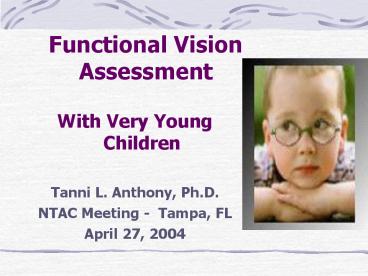Functional Vision Assessment - PowerPoint PPT Presentation
1 / 31
Title:
Functional Vision Assessment
Description:
Parent input and participation are essential, as it a team approach. ... Scotoma. Tunnel Vision. Light Sensitivity. Light-Dark Adaptation. Contrast Sensitivity ... – PowerPoint PPT presentation
Number of Views:1067
Avg rating:3.0/5.0
Title: Functional Vision Assessment
1
Functional Vision Assessment
- With Very Young Children
- Tanni L. Anthony, Ph.D.
- NTAC Meeting - Tampa, FL
- April 27, 2004
2
FUNCTIONAL VISION ASSESSMENT
- Assessing what HELPS visual performance
- Assessing what HINDERS visual performance
3
1.1.5.T1
4
Philosophy of Assessment
- Parent input and participation are essential, as
it a team approach. - It takes time to complete a FVA.
- The FVA should reflect real life learning and
activities. - It is key to determine the childs learning
style. - Qualitative and quantitative skills should be
noted in a FVA.
5
FACT FINDING
- Medical Information
- Developmental Information
6
The Visual Response Continuum
- Awareness ????Attention???Understanding
- Lights ?????? People ???? Objects
- Fixation????????????? Tracking
- Near??????????????? Far
- Peripheral ????????????Central
- Familiar ????????????? Unfamiliar
- Parts ?????????????? Wholes
- Simple ????????????? Complex
- Large ????????????? Small
7
Pieces of the FVA Puzzle
8
Emotional Safety / Rapport
- The infants first tasks are attachment and
sensory regulation. These are the building
blocks to effective and efficient visual skill
development. - Stress will negatively impact visual performance.
9
Familiar vs. Unfamiliar
- Authentic Assessment in the early years
- completing assessments in settings familiar to
the child - with people who are familiar to the child.
- with objects that are familiar to the child.
10
Environmental Control
- Pay attention to
- Focal Distance / Size / Angle
- Lighting
- Auditory Distractions
- Visual Clutter
- Contrast / Color
11
Positioning
- Ensure the child is in a supported posture.
- Hips support trunk support head support.
- Focus should be on looking and not maintaining
balance.
12
Vision is not the Only Learning Sense
- FVA should not be completed in isolation of other
sensory assessment. - Utilize other tools and other professionals to
build a true perspective of childs individual
sensory learning profile.
13
Sensory Targets
- Be aware of the sensory hierarchy.
- Look for preferences.
14
Sequence of Sensory Development
Touch Vestibular Taste
Smell Auditory
Vision
15
Wait Time
- Be patient it may take some infants a very
long time to initially respond to sensory stimuli.
16
FVA Components First Glance
- Appearance of Eyes
- Presence of Nystagmus
- Corrective Lenses
17
FVA ComponentsVisual Reflexes
- Pupillary Response
- Defensive Blink
- Dolls Eye Response
18
Reception and Perception of Visual Stimuli
- Light Perception
- Light Projection
- Shadow and Form Perception
- Hand Motion
19
COLOR VISION
- Genetic Predisposition
- Eye Condition
- Simple Preferences
20
MUSCLE IMBALANCE
- Eso
- Exo
- Hyper
- Hypo
21
Eye Preference
- Anisometropia
- Nystagmus Equity
- Monocular Items
22
OCULAR MOTOR BEHAVIORS
- FIXATION
- CONVERGENCE
- DIVERGENCE
- TRACING
- TRACKING
- SHIFT OF GAZE
- SCANNING
23
Eye Teaming Continued
- Depth Perception
- Figure- Ground
- Perception
24
Field of Vision
- Hemanopsia
- Scotoma
- Tunnel Vision
25
- Light Sensitivity
- Light-Dark Adaptation
- Contrast Sensitivity
26
VISUAL ACUITY
- Preferred Viewing Distance
- Near and Distance
- Force Preferential Looking
- Functional Acuity
27
Reading Rate Comprehension
- Classroom materials
- Reading Efficiency Kit materials.
- Community materials.
28
Visual Motor Coordination
- Gross Motor Tasks
- Fine Motor Tasks
- Handwriting Skills
29
VISUAL COGNITIVE SKILLS
- Imitation
- Identification
- Matching, Sorting, Classifying
- Sequencing
30
VISUAL PERCEPTION SKILLS
- Visual Closure
- Part-Whole
- Pattern Recognition
- Figure-Ground Discrimination
- Spatial Orientation
31
- The
- end

